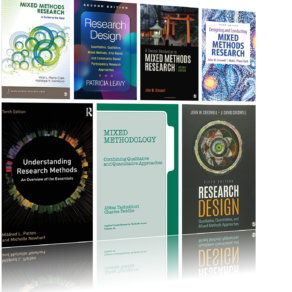Mixed methods research is a distinctive approach that combines both quantitative and qualitative research methods within the same study. This approach aims to benefit from the strengths of both types of research methods to provide a broader, more comprehensive understanding of the research problem.
In an earlier post, we delved into the details of mixed methods research, discussing its definition, types, advantages, disadvantages, and more. If you haven’t already, you may want to start there to get a solid grasp of the concept. For those seeking to dig deeper into the subject, we have also curated a list of the best books on mixed methods research in another post.
Today, we move forward and present real-world examples of studies that have successfully applied the mixed methods research approach. The goal is to help you visualize how mixed methods are utilized across various fields and the unique insights they can generate.
Through each example, we will see how the integration of qualitative and quantitative data can provide a richer understanding of the research problem, often leading to more robust and well-rounded conclusions.
Whether you are a student, a researcher, or simply someone intrigued by the Mixed Methods Research approach, these examples will surely provide some valuable insights.
Mixed Methods Research Examples
Here are some interesting examples of peer-reviewed research papers using mixed methods approach:
1. Research Study N1
1. Kara, N. (2018). Understanding University Students’ Thoughts and Practices about Digital Citizenship: A Mixed Methods Study. Educational Technology & Society, 21(1), 172–185.
Summary: This study explores the perceptions and behaviors of university students regarding digital citizenship. A two-phased mixed methods approach was used, beginning with a quantitative survey administered to 435 students from a private university. This phase determined that students tend to avoid engaging in political activities online. To further understand this, a qualitative phase followed, involving semi-structured interviews with 10 students. They expressed their aversion was due to emotional disturbance, societal pressure, and fears of negatively impacting their future.
Mixed Methods Usage: The study exemplifies a sequential explanatory mixed methods design. It starts with a quantitative survey to provide a broad view of students’ behaviors and thoughts about digital citizenship. The qualitative phase then follows up on these results, offering a deeper understanding of the identified behaviors and attitudes by conducting interviews.
2. Research Study N2
2. Gerrity, K. W., Hourigan, R. M., & Horton, P. W. (2013). Conditions That Facilitate Music Learning Among Students With Special Needs: A Mixed-Methods Inquiry. Journal of Research in Music Education, 61(2), 144–159. http://www.jstor.org/stable/4199957
Summary: This mixed-methods study aimed to identify the conditions that foster learning in music among students with special needs. The students attended weekly music sessions for ten weeks, and their musical ability was assessed through pre- and posttest evaluations. The analysis found a significant improvement in musical skills, with teaching strategies like repetition, student choice, and increased response time playing a crucial role. Semi-structured interviews with all participants, including children, parents, mentors, and supervisors, were used to understand the conditions that led to this growth.
Mixed Methods Usage: The study uses a concurrent design where quantitative data (pre-and posttest scores) and qualitative data (semi-structured interviews) were collected and analyzed in parallel. This provided a comprehensive understanding of how the teaching strategies and environmental conditions facilitated musical learning among students with special needs.
3. Research Study N3
3. Reynolds, Barry Lee (2015). A Mixed-Methods Approach to Investigating First- and Second-Language Incidental Vocabulary Acquisition Through the Reading of Fiction. Reading Research Quarterly, 50( 1), 111– 127. doi:10.1002/rrq.88
Summary: The study investigates whether reading fiction can lead to incidental vocabulary acquisition in both first- and second-language speakers. The experimental groups were given a novel containing made-up words, followed by a surprise recall translation assessment and a reflective questionnaire. The results showed that English-L1 speakers acquired vocabulary more efficiently than English-L2 speakers through reading, with just three encounters with unknown words proving sufficient if the reader found the text enjoyable or important. Further interviews revealed differences in how the two groups perceived these made-up words, suggesting that the use of made-up words in vocabulary acquisition research could confound results.
Mixed Methods Usage: The study employs a sequential explanatory design, starting with quantitative methods (surprise recall translation assessment) to measure the acquisition of made-up words. This is followed by qualitative methods (reflective questionnaire and post hoc interviews) to explore the reasons behind the different acquisition rates among English-L1 and English-L2 speakers, thus providing a deeper understanding of the initial quantitative results.
4. Research Study N4
4. Black MM, Ricardo IB. Drug use, drug trafficking, and weapon carrying among low-income, African-American, early adolescent boys. Pediatrics. 1994 Jun;93(6 Pt 2):1065-72. PMID: 8197009.
Summary: This study aims to understand the relationships between high-risk behaviors like drug use, drug trafficking, and weapon carrying among low-income, urban, African-American boys aged 9 to 15 years. Using both quantitative and qualitative methods, the research explores personal risk practices, intentions to engage in risk behaviors, the influence of family, friends, and community on risk taking, and values toward risk practices. The study also examines the roles of sensation seeking, perceived peer pressure, and parent-child communication.
Mixed Methods Usage: The study employs a sequential explanatory design where quantitative data collection and analysis is conducted first, followed by qualitative data collection and analysis to help explain or build upon the quantitative results. In the quantitative phase, boys complete a computer-assisted survey and standardized assessments. In the qualitative phase, in-depth interviews are conducted to provide further insights into drug activities and violence. The two methods together provide a comprehensive understanding of the high-risk behaviors among the target group.
5. Research Study N5
5. Flanagan PJ, McGrath MM, Meyer EC, Garcia Coll CT. Adolescent development and transitions to motherhood. Pediatrics. 1995 Aug;96(2 Pt 1):273-7. PMID: 7630683.
Summary: This research study investigates the experience of motherhood during adolescence and evaluates the influence of developmental factors on the concept of maternal role. Using both qualitative and quantitative methods, it found that an adolescent mother’s perception of her maternal role is closely linked to her psychosocial and cognitive development. The study also showed a strong correlation between the complexity of responses to questions about self and about motherhood.
Mixed Methods Usage: The study employs a sequential exploratory design. A qualitative grounded theory approach was initially used (via focus groups and individual interviews) to generate a hypothesis, followed by a quantitative method (structured interviews using scored questions) to test this hypothesis. This strategy provides a rich and detailed understanding of the transition to motherhood during adolescence.
6. Research Study N6
6. Way, N., Stauber, H. Y., Nakkula, M. J., & London, P. (1994). Depression and substance use in two divergent high school cultures: A quantitative and qualitative analysis. Journal of Youth and Adolescence, 23(3), 331-357. https://doi.org/10.1007/BF01536723
Summary: This study explores the relationship between adolescent depression and substance use across two culturally different environments: a suburban and an inner-city high school. While a positive association was found between depression and substance use among suburban students, no such association was observed for urban students. The study suggests that these differences may be due to varied meanings of depression and substance use informed by cultural context.
Mixed Methods Usage: The study employs a concurrent design, where quantitative (questionnaires and substance use measures) and qualitative methods (in-depth semi-structured interviews) were used simultaneously. This helped the researchers to explore and understand the relationships between depression and substance use across different cultural contexts.
7. Research Study N7
7. Baumann, C. (1999). Adoptive fathers and birthfathers: A study of attitudes. Child & Adolescent Social Work Journal, 16(5), 373–391. https://doi.org/10.1023/A:1022347729368
Summary: This research explores the attitudes of 113 adoptive fathers towards birthfathers. It investigated the influence of various factors, including media, social workers, preparation prior to adopting, and others on their attitudes. The study found that preparation before adoption significantly contributed to positive attitudes towards birthfathers, with social workers playing a critical role in fostering this positivity.
Mixed Methods Usage: While the methodological details are not explicitly mentioned in the abstract, it appears that the study utilized both qualitative (in-depth exploration of feelings, thoughts, experiences, etc.) and quantitative methods (structured assessments to quantify attitudes). This mix of methods would provide a rich understanding of the factors shaping adoptive fathers’ attitudes.
8. Research Study N8
8. Tashiro J. Exploring health promoting lifestyle behaviors of Japanese college women: perceptions, practices, and issues. Health Care Women Int. 2002 Jan;23(1):59-70. doi: 10.1080/073993302753428438. PMID: 11822559.
Summary: The study aimed to investigate health-promoting lifestyle behaviors (HPLBs) of college women in Japan. Using both qualitative and quantitative methods, it found that perceived HPLBs, health status, and health concerns were mutually associated. The study also suggests that the number of perceived health concerns and motives or cues important to college women must be considered to promote healthy lifestyle behaviors.
Mixed Methods Usage: The research adopts a sequential exploratory design, using focus group data to create a questionnaire, which was then administered to a larger sample. This approach provided deeper insights into health behaviors and perspectives of Japanese college women, while also allowing for a broader understanding of their perceived health status
9. Research Study N9
9. Ely, R. J. (1995). The Power in Demography: Women’s Social Constructions of Gender Identity at Work. The Academy of Management Journal, 38(3), 589–634. https://doi.org/10.2307/256740
Summary: This study explores how the proportion of women in senior roles within organizations influences professional women’s perceptions of gender difference and gender identity at work. Findings suggest that gender roles tend to be more stereotypical and problematic in firms with a lower proportion of senior women. The study also identified five response profiles to these constraints, challenging the view of gender as a property synonymous with biological sex, and supports a perspective of gender as a social construct influenced by power dynamics in an organization’s hierarchy.
Mixed Methods Usage: The study employs a mixed methods approach, though the specific design is not clarified in the abstract. It likely involves collecting qualitative data to understand women’s perceptions and responses, and quantitative data to examine the correlation between these perceptions and the proportion of senior women in the organization. This would provide a holistic understanding of the influence of organizational demographics on gender identity at work.
10. Research Study N10
10. Gogolin, L. and Swartz, F. (1992), A quantitative and qualitative inquiry into the attitudes toward science of nonscience college students. J. Res. Sci. Teach., 29: 487-504. https://doi.org/10.1002/tea.3660290505
Summary: This research investigates the attitudes of nonscience college students towards science using both qualitative and quantitative approaches. Findings reveal significant differences in attitudes towards science between nonscience and science students, with nonscience students showing a favorable change in attitudes following instruction. The study also suggests that attitudes towards science are influenced by both school and nonschool variables.
Mixed Methods Usage: The study uses a concurrent design, where quantitative (Attitudes Toward Science Inventory) and qualitative methods (interviews) were used simultaneously. This approach allowed researchers to measure attitudes and changes in attitudes quantitatively, while also exploring the factors contributing to these attitudes in a more open-ended and nuanced way through interviews.
11. Research Study N11
11.Guerra, N.G., Williams, K.R. and Sadek, S. (2011), Understanding Bullying and Victimization During Childhood and Adolescence: A Mixed Methods Study. Child Development, 82: 295-310. https://doi-org.ezproxy.msvu.ca/10.1111/j.1467-8624.2010.01556.
Summary: The study aims to understand the predictors of bullying and victimization, including how these predictors vary with age and gender. Survey data from students across different school levels and focus group discussions revealed that low self-esteem, negative school climate, and normative beliefs supporting bullying are significant predictors. The study provides insights into bullying dynamics and its connection to sexuality and social identity during adolescence.
Mixed Methods Usage: The research design uses a sequential explanatory design, where quantitative survey data collection and analysis is followed by qualitative focus group discussions to gain deeper insights into the factors identified through the survey. This provides a comprehensive understanding of bullying and victimization in the school context.
12. Research Study N12
12. Cooper, K. S. (2014). Eliciting Engagement in the High School Classroom: A Mixed-Methods Examination of Teaching Practices. American Educational Research Journal, 51(2), 363–402. https://doi-org.ezproxy.msvu.ca/10.3102/0002831213507973
Summary: This case study analyzes how student engagement varies across different classes in a diverse high school, examining the types of teaching practices that promote engagement. The study identifies connective instruction as a strong predictor of engagement, and it proposes a typology for teaching practices aimed at engagement.
Mixed Methods Usage: The study employs a convergent parallel design, gathering both quantitative (student surveys) and qualitative data (interviews and observations) separately but concurrently. The integration of findings from both methods assists in providing a robust analysis of student engagement and teaching practices.
13. Research Study N13
13. Hoffman, B., & Nadelson, L. (2010). Motivational engagement and video gaming: a mixed methods study. Educational Technology Research and Development, 58(3), 245–270. http://www.jstor.org/stable/40603176
Summary: This study investigates factors related to motivational engagement in video gaming. Results reveal that motivational engagement is associated with gender, hours of play, task orientation, and socialization. The study concludes that the transfer of motivational engagement from gaming to educational contexts is unlikely.
Mixed Methods Usage: The research uses a convergent parallel design where quantitative (surveys) and qualitative methods (interviews) are used concurrently. This approach provides a broad understanding of the factors associated with motivational engagement in gaming.
14. Research Study N14
14. Klingner, J. K., & Boardman, A. G. (2011). Addressing the “Research Gap” in Special Education Through Mixed Methods. Learning Disability Quarterly, 34(3), 208–218. http://www.jstor.org/stable/23053308
Summary: The paper discusses the benefits of mixed methods research in special education, arguing that some challenges in this field, such as the disproportionate representation of culturally and linguistically diverse students, can be better addressed through a combination of different types of research.
Mixed Methods Usage: This paper doesn’t present original mixed methods research but advocates for the use of mixed methods in special education research. The authors stress the importance of incorporating cultural aspects and provide an overview of mixed-methods research, comparing educational research with medical field research.
Final thoughts
Mixed methods research serves as a versatile tool that can navigate the complex terrain of various research problems by integrating quantitative and qualitative methods. Through the real-world examples provided, we’ve explored how this research approach can offer nuanced insights that neither quantitative nor qualitative research could provide on its own.
Whether you’re researching in education, healthcare, or any other field, the application of mixed methods research offers an enriched perspective that can lead to more substantial conclusions and policy recommendations. If you’re looking to deepen your understanding of mixed methods or other research methodologies, don’t forget to check out my Research Methodology section for curated reading lists, resources, and more.






